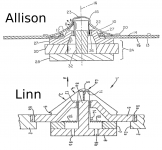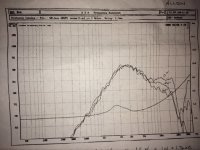It actually wasn't that innovative, but by the standards of past times was quite good:
I can think of a lot of modern tweeters that do much the same things, but where Roy Allison was good was that in realising that power response was as important as frequency response. I certainly apply this idea myself.
Presumably, you are seeking to replace broken tweeters. Well, TBH, you should move with the times. Either that or waste money on fleabay.
Roy F. Allison Interview | Hi-Fi | Feature | AVHubSM: The transducers used in the Allison One looked proprietary. What were the design criteria for the dome tweeter, dome midrange and woofers?
RA: The midrange and tweeter units are not really domes in the usual sense. They are convex radiators, but each is driven by a voice coil at approximately half the distance from the centre to the suspension edge. Neither has a spider. The cone part of the tweeter, although convex overall, is curved inward and the outer edge is clamped through a very thin ring of latex foam to the mounting plate. Thus the radius of curvature of the cone changes as the voice coil moves, simulating a pulsating hemisphere that puts large amounts of high-frequency energy into the reverberant field all the way up to 20kHz. The midrange unit has a straight-sided cone with a flexible polyethylene edge suspension. It has extremely wide and uniform dispersion over its operating range… as does the tweeter.
Neither is proprietary inasmuch as they’re not protected by patents, but they are difficult and time-consuming to make properly, and they do project relatively far out from the front cabinet panel, which complicates the grille design. They have not been imitated, probably for those reasons.
I can think of a lot of modern tweeters that do much the same things, but where Roy Allison was good was that in realising that power response was as important as frequency response. I certainly apply this idea myself.
Presumably, you are seeking to replace broken tweeters. Well, TBH, you should move with the times. Either that or waste money on fleabay.
There is no modern tweeter capable of as wide dispersion as Allison's tweeter. It was innovative than, and it is innovative now as well, by both past and modern standards.It actually wasn't that innovative, but by the standards of past times was quite good
I can think of a lot of modern tweeters that do much the same things,
Wide dispersion from conventional modern and old tweeters is possible only with some complex waveguides//phase plugs/slots/lenses/reflectors.
Does anyone know if the tweeters in the vintage Allison two-way designs and three-way designs were the same. Specifically, were the tweeters in Allison 4s the same as the ones in Allison CD-8s ?
Thanks.
No, the frequency response is different between 2-way and 3-way. 2-way tweeter (usually cross-over at ~2kHz) has more mid-range output than the 3 way tweeter (cross-over at ~4kHz). The cross-over in most early Allison speaker is very simple, so the original frequency response of the drivers play a big role in determining the cross-over frequency.
Go to Classicspeakerpages.net and Yahoo group allison-speakers for more info.
Of all of the brilliant minds with which the audio world was gifted in the past half century that are deserving of cloning, Roy should be in anyone's top 5 list
funny how some of the best escaped notice?
funny how some of the best escaped notice?
Forgotten today perhaps but he was very well know and respected in his time.
Attachments
Last edited:
Not to spoil the party, but I would like to see detailed polars of that RA tweeter before I believe any of the claims. Audio is full of patents and the according claims, whereas very few can substantiate these claims in real life.
BTW: it should not be too hard to construct something like that: take a 2-3 inch FR cone driver, cut the cone loose and mount it reversed. Steve Deckert (is that the name?) did something like that a long time ago, if I am not mistaken.
Good luck,
Eelco
BTW: it should not be too hard to construct something like that: take a 2-3 inch FR cone driver, cut the cone loose and mount it reversed. Steve Deckert (is that the name?) did something like that a long time ago, if I am not mistaken.
Good luck,
Eelco
Kinda OT but, thought this was nice. 
The Relexions: an Allison 4 inspired speaker design - Techtalk Speaker Building, Audio, Video Discussion Forum
The Relexions: an Allison 4 inspired speaker design - Techtalk Speaker Building, Audio, Video Discussion Forum
Indeed, one of Steve's cute little tricks - larger driver, and was supported by a fairly conventional dome IIRC? I heard a pair of the original prototypes in 2001, and they sounded nice enough, but nothing magical. The little Zen EL84 amps, however were very nice - and quite reasonably priced as kits back then .
DECWARE Radial Omni Loudspeaker model ERRx
and the preceding white paper,
DECWARE - Radial Speaker Project
Might be hard though to find modern day measurements of any of the Allison products that would satisfy your requirements
DECWARE Radial Omni Loudspeaker model ERRx
and the preceding white paper,
DECWARE - Radial Speaker Project
Might be hard though to find modern day measurements of any of the Allison products that would satisfy your requirements
Not to spoil the party, but I would like to see detailed polars of that RA tweeter before I believe any of the claims. Audio is full of patents and the according claims, whereas very few can substantiate these claims in real life.
BTW: it should not be too hard to construct something like that: take a 2-3 inch FR cone driver, cut the cone loose and mount it reversed.
Linn "tweeter" is fundamentally different from Allison tweeter. A far as I can see, Linn tweeter has rigid inverted cone - not good for a high-frequency dispersion. Allison tweeter has flexible concave diaphragm around the 1/2" convex dome.
No graphical diagrams, but measurements text data in:
Allison Six Speaker System Review price specs - Hi-Fi Classic
Quote: "...about 30 degrees apart as seen from the microphone position) were very similar, diverging significantly only at frequencies above 10,000 Hz. This confirms the broad dispersion claimed for this tweeter. "
Last edited:
@Sonce: without at least knowning the Youngs Modulus and Poissons ratio of the diaphragm material it is -unfortunately- near impossible to make any valid statement about the radiating properties of so called "rigid" materials. FEM is necessary to do it all in detail and with some accuracy. Furthermore, I remain skeptic about the statement in Hifi Classic: words, but no measurements to back it up.
It still do think the RA design is interesting. Isn't there someone out there on DIYAudio who happens to own these Allisons and is capable of making on and off axis measurements with 5 degree increments from 0 to 90 degrees?
Regards,
Eelco
It still do think the RA design is interesting. Isn't there someone out there on DIYAudio who happens to own these Allisons and is capable of making on and off axis measurements with 5 degree increments from 0 to 90 degrees?
Regards,
Eelco
Many years back, a certain hi fi journalist and I had a long back and forth about the Allison tweeter on the r.a.o. newsgroup. He had to be the most loyal Allison groupie ever and claimed that the Allison tweeter was perfect. I think he and Roy were personal friends. Mind you, this was when the tweeter design was about 35 yrs old. So basically, according to this journalist, all the following efforts of the best Scandinavian engineers were for nought, because Roy Allison had perfected the tweeter, and everybody else was building inferior designs. At the time I was working for SEAS, and found this a rather bold claim. So I managed to get a pair of Allison tweeters (these were for the 2 ways, the only difference being that Allison put some silicone grease in the gaps, apparently to damp the larger excursions), and I sent them to Norway for evaluation. The response graph (which I'm amazed I still have) is shown below. We checked 2 units to make sure this wasn't an anomaly, and Roy Allison did confirm that the measurements were fairly representative. It indeed has wide dispersion at the top end above 10kHz. Certainly wider than a 1" or 3/4" dome. However, the overall response just makes it to 20kHz on axis. The overall response is also obviously not flat and therefore requires crossover compensation. Taking that into account, the on axis sensitivity is really very low. The impedance curve is also very ragged, indicating a lot of small resonances present in the moving system. And compared with a modern tweeter, a sine sweep sounds pretty "hashy". IMO, the design is a pretty mixed bag, once again confirming that there's no free lunch in driver design.
Attachments
Last edited:
Well, all we need actually is to see a patent drawing from post #10 for a Linn tweeter: 3 is a inverted cone and 5 obviously is a flexible half-roll surround. Logicaly, flexible surround goes together with a rigid cone. Simply as that. I wouldn't even bother to read the Linn patent to verify this.@Sonce: without at least knowning the Youngs Modulus and Poissons ratio of the diaphragm material it is -unfortunately- near impossible to make any valid statement about the radiating properties of so called "rigid" materials. FEM is necessary to do it all in detail and with some accuracy.
jmsent,
Thank you for a very interesting graph and associated comments.
Looking at the SPL graph and the cross-section drawing of the Allison, I would not be surprised if it would appear from e.g. laser interferometry or similar measurements, the cone like assembly moves pistonic to about 6 kHz, and then is decoupled and the sort-of-dome/dustcap on top of the vc takes over.
But then again, this is only guesswork.
Regards,
Eelco
Thank you for a very interesting graph and associated comments.
Looking at the SPL graph and the cross-section drawing of the Allison, I would not be surprised if it would appear from e.g. laser interferometry or similar measurements, the cone like assembly moves pistonic to about 6 kHz, and then is decoupled and the sort-of-dome/dustcap on top of the vc takes over.
But then again, this is only guesswork.
Regards,
Eelco
- Status
- This old topic is closed. If you want to reopen this topic, contact a moderator using the "Report Post" button.
- Home
- Loudspeakers
- Multi-Way
- Tweeters in Allison Loudspeakers

